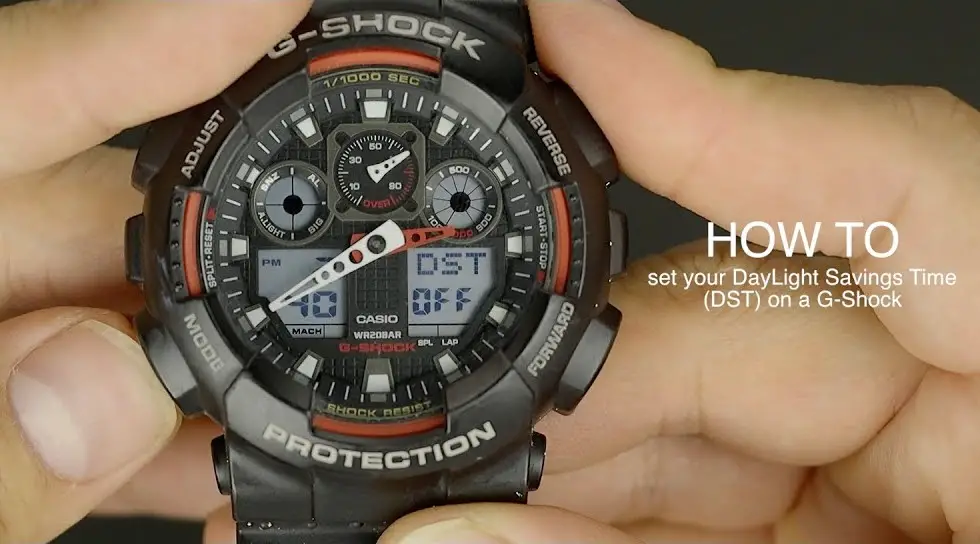How to Set Daylight Saving Time On Casio G-Shock Watch

One of the many things we cannot do without is a good watch that tells us time. Many good watches out there come with multiple functions that provide their precision. Even if a broken clock tells time right twice a day, you want your timepiece to be as reliable as it can be.
Here’s a quick video that shows how to turn Daylight Saving Time on and off on a G-Shock:
What does Daylight Saving Time (DST) mean?
The Daylight Saving Time (DST) is a reliable method of turning the clock ahead as warm weather is getting closer. We also use the function when the weather gets cold so that we gain another hour of daylight in the afternoon. It gives people one more hour in the evening during the warm season.
On the side note, some people suggest that the functions should be called “Daylight Shifting Time” as we don’t save any daylight.
There are differences between various countries when it comes to Daylight Saving Time. For instance, the method isn’t standard for equatorial and tropical climates even though countries and northern and southern hemisphere do set ahead/back the clock, the months when they’re doing it differently.
For example, the U.S. Energy Policy Act of 2005 establishes several changes on the Daylight Saving Time, so that it can be done one week later in the fall and three weeks earlier in the spring. Ever since March 11 back in 2007, clocks “gain” a single hour on the 2nd Sunday of March. It’s the first Sunday in November when they fall back. The changes are supposed to reduce the need for artificial lights and, therefore, save energy.
Why do we need to use Daylight Saving Time?
Time disparity may lead to sync and planning difficulties for unfixed applications, devices, and systems. On the long run, the discrepancies may impact the operations in the specific areas, but also the systems related to the theme.
Let’s see the variations of Daylight Saving Time around the world:
- Most clocks in most of North America are set forward one hour on the 2nd Sunday in March. Every November, on the first Sunday, they’re going to be set back.
- For Brazil, the DST begins the 1st Sunday in November, ending in the 3rd Sunday of February
- There is no DST in Arizona in the US, but the Navajo Reservation does confirm it.
- Russia is setting the clocks ahead in the last Sunday in March at 2 am (local time). It’s going to set it back in the last Sunday of October (same time). As the clock is already set one hour ahead of standard time, Russians are getting two extra hours of daylight during the summer time.
- It’s the last Sunday in March at 1 am when the European Union begins the DST, ending it on the last Sunday in October.
- Jordan experiences DST throughout the entire year
- Even if both Palestine and Israel observe DST, the time they’re changing it is different every year. They may set different start and end dates.
- DST begins in Australia begins on the last Sunday in October, and it ends in March, on the last Sunday. New Zealand and Tasmania are starting it on the first Sunday in October. However, Tasmania is ending it the last Sunday in March, whereas New Zealand finishes on the 3rd Sunday in March.
Setting Daylight Savings Time On Casio G-Shock Watch
Even if there are so many G-Shock watches out there, there are similarities for setting DST on G-Shock watches.
You may start by holding the adjust button until the button on the right corner is going to start blinking.
Continue with hitting the mode button as you need to find the DST function on your G-Shock.
By Default, the DST should be set to OFF. You’re going to hit the forward button and toggle between On and Off. Be patient about it as you’re going to have to run to find the analogic setting. Once you find it, you press it.
No matter your G-Shock model, you can always get the guidance from the operation instruction manual of the watch.
What’s the role of the time calibration signal?
Any watch has to get the time calibration signal so that it runs various calculations which are fundamental for accurately identifying time. Running the estimates are going to lead a setting off by up to one second.
The watches aren’t making allowances for the DST, which is why one has to change the DST setting to the “Auto DST.” Your watch is going to set the hour automatically.
Don’t forget that you need to turn off the DST setting when you are in an area where there is no observation of DST.
There aren’t many G-Shock models that don’t feature the Auto DST setting; in which case you can do it manually (go back to the steps we’ve mentioned above).
What can you do for increasing the quality of time calibration signal reception?
To improve your watch’s accuracy, no matter where you are in the world, you need to remember a couple of things:
- You may adjust the signal reception by placing the watch with the noon side face towards a window. Check to see that there are no metal objects close to the clock.
- You may have to wait 5 minutes or so until time calibration signal reception takes place. It can also take around 12 minutes to make sure you’re not running any buttons on your watch during that time
- Signal reception is improved at night and not during the day
- The signal reception may suffer in several conditions:
- Inside a vehicle
- Among/behind mountains
- Near an airport, construction site, or places with significant electrical noise
- Near a mobile phone, office equipment, or household appliances
- Inside a building
One last observation before you go
Daylight Saving Time is the right name, and not Daylight Savings Time. The name tells about its nature, as it relates to the activity of saving daylight.
It’s easier to change the batteries in the smoke detectors in the house when you’re also changing the clock. Having smoke detectors with drained batteries is just as bad as not having them at all. Thanks to the DTS on your clock, you can always rely on your smoke detectors.
RESOURCES
https://whatis.techtarget.com/definition/Daylight-Saving-Time-DST
https://support.casio.com/en/support/answer.php?cid=009001018001&qid=75753&num=1

